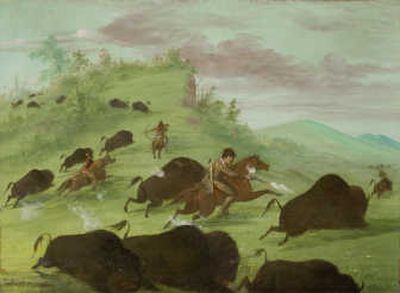The art of innovation

Samuel Colt’s name is synonymous with revolvers – the Walker Colt, the Colt Navy Revolver and the Colt .45.
So naturally, revolvers by the dozen are at the heart of this new traveling exhibit, “Samuel Colt: Arms, Art and Invention,” at the Northwest Museum of Arts and Culture.
Yet Colt was far more than a maker of guns. He was an inventor, engineer, industrialist, huckster, advertising innovator and friend to sultans and czars. At the height of his career in the 1840s and 1850s, Colt may have been the most famous American in the world – or, as guest curator Herbert Houze called him, “the Bill Gates of his time.”
That gives this history exhibit, one of the most elaborate ever mounted at the MAC, unusually wide appeal. The combination of guns and art should “appeal to a broader audience than either art or firearms separately,” said Marsha Rooney, senior curator of history at the MAC.
In some ways, it’s the story of American capitalism from the 1830s through Colt’s death in 1862. Colt’s talent as an innovator went far beyond inventing a foolproof revolving pistol cylinder, according to Houze, who wrote this exhibit’s companion book and delivered a lecture at the MAC on Saturday. Colt was also responsible for the following:
• The invention of the production line. By streamlining the production process, the Colt factory in Hartford could make a revolver, start to finish, in two hours and 45 minutes. A half-century later, Henry Ford’s innovation was to put the production line on a moving track.
• Celebrity endorsement and product placement. Colt commissioned George Catlin, one of the most famous artists of the American West, to paint oils showing Catlin himself shooting buffalo, deer and jaguars. The guns were Colts, of course. One of these paintings, of Catlin shooting a buffalo from horseback, became one of the best-known Western images of all time.
• Creating the phrase, “new and improved.” Colt designed his own advertisements and was the first to coin this phrase, according to Houze. Advertisers have been using it ever since.
Colt’s talent for marketing shouldn’t be too surprising, since the young Colt earned money for his first prototype pistols by working as “Dr. S. Coult,” a traveling purveyor of nitrous oxide (laughing gas).
This exhibit, created for the Wadsworth Atheneum Museum of Art in Hartford, Conn. (Colt’s hometown), creates a wide-ranging portrait of this influential figure.
The exhibit features:
Paintings: Five oil paintings and six lithographs by Catlin, as well as a several large-scale portraits of Colt and his family.
Jewels: Colt traveled the world marketing his guns and being courted by world leaders. The exhibit includes a number of elaborate presents, including a diamond-studded snuffbox from Czar Alexander II, another diamond-studded snuffbox from Sultan Abd-al-Majid, a gold-and-silver vase from the king of Siam and diamond rings from Czarina Alexandra, Czar Nicholas I and the king of Sardinia.
Yet nobody will be able to complain about a dearth of guns in this show – there are more than 100 of them, fitting for an exhibit partially supported by the National Rifle Association (Mackay Manufacturing of Spokane is the lead sponsor). The show includes:
Early firearms from around the world: The exhibit contains a number of pre-Colt firearms, going all the way back to a mid-15th century hand cannon from China, an 18th century matchlock revolver from India, and a 1680s revolving carbine from London. Most of these old weapons came from Colt’s own collection.
A wide array of Colt firearms: Colt’s own models, more than 50 in total, are the backbone of the exhibit. About 18 Colt guns are elaborately displayed in a “compass rose” display, a geometric form that Colt himself used to market his guns at the Crystal Palace exhibition in London.
Some of the notable Colt guns include:
• The Colt Pocket Pistol – A small pistol with a barrel only four or five inches long. It was an immediate success, with one model selling over 300,000 copies. It was also marketed successfully to women with the catchphrase, “The Lady’s Companion.”
• The Holster Pistol – This was a large .44 caliber pistol, 14 inches long, which proved immensely popular for prospectors heading to the ‘49 California Gold Rush.
• The Walker Colt – This was another, even larger model of the Holster Pistol, a powerful revolver designed by Colt for Capt. Samuel Hamilton Walker, of Texas Ranger fame. Colt made hundreds for the Texas Rangers and 1,000 for the U.S. government, many of which were used in the Mexican-American War. It became a huge seller and one of the most important guns in the American West.
• The Colt Revolving Belt Pistol – Also known as the Navy Revolver, this .36 caliber revolver was one of Colt’s big sellers.
• The Colt New Model Carbine – Colt didn’t make only pistols. This rifle was one of the company’s most popular long arms.
One revolver you won’t see in this exhibit: The Colt .45, also called the Peacemaker (officially called the Single Action Army). The most famous of all Old West pistols was made by the Colt company beginning in the 1870s, long after Colt’s death. That pushes it outside the scope of this exhibit. However, there is a Colt .45 from the MAC’s own collection on display in an auxiliary exhibit, called “Ready, Aim … How Firearms Work” in an adjacent small gallery.
In any case, this traveling exhibit is not about Colt the revolver, but Colt the man. A stroll through these displays might help you understand why Colt was even credited, in the popular imagination, with assisting the Almighty in an important task.
“God created man,” the old saying went. “But Sam Colt made men equal.”